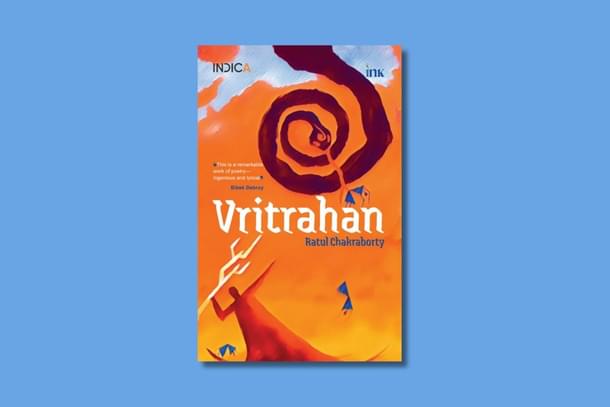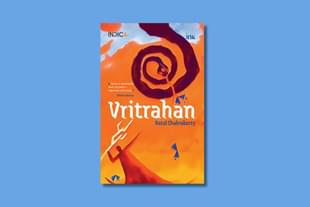Books
The Search For Meaning In A Modern World: How Ancient Tales Show Us The Way
Gowri Subramanya
Jan 19, 2025, 05:53 PM | Updated Feb 11, 2025, 02:02 PM IST
Save & read from anywhere!
Bookmark stories for easy access on any device or the Swarajya app.


Vritrahan. Ratul Chakraborty. Occam. Pages 346. Rs 490.
What ails us? What ails the modern world? Depending on who you ask, there is a long list of ailments that individuals and the collective humanity are battling. Most ailments feel modern, something the older generations didn’t face, or so we say: the vice grip of greed, hunger, envy, the unending race to get “there” first, to grab everything we can, the cruelty towards the “lesser,” the “other,” or even towards nature which holds and sustains us, and ultimately the insatiety of it all, feels like we are at the precipice of humanity’s downfall. But we would be hard-pressed to pinpoint the root of what ails us.
Ratul Chakraborty’s new book Vritrahan, which I thought would be a simple retelling of an ancient story attempts to not only pinpoint the root of our ailment but also shows us the way to redemption through a grand narrative that traces the core tenets of Hindu philosophy.
There are stories that entertain, stories that teach, and then there are stories that transform. Ratul Chakraborty’s Vritrahan belongs to the rarest of these categories — a story that is as much about the universe outside as it is about the universe within.
At its core, Vritrahan is based on one of the oldest Vedic stories: the slaying of Vritra, the serpent of drought and stagnation, by Indra, the king of the gods. Chakraborty doesn’t just tell the story of Indra’s battle. He layers it with rich symbolism and philosophical depth, weaving in the principles of Dharma (moral order), Purushartha (life’s purpose), and the mysteries of birth and death. He explores the fraught relationship between devatas and humans, the resilience of humanity, and the timeless choice between fear and love — all within the sweeping grandeur of a cosmic play.
To undertake a project of this scale and ambition is remarkable; to execute it so beautifully is a testament to Chakraborty’s vision and skill.
The story of Vritrasura is one of those stories that should be more widely known but is only a faint memory, like a footnote in Indra’s biography. We only ever think of it when we come across Indra’s epithet: Vritrahan, the slayer of Vritra. Chakraborty takes this deva-asura battle and turns it into a journey of redemption and self-discovery.
One of the most profound themes of Vritrahan is the search for Purushartha — life’s purpose. Chakraborty doesn’t present purpose as a static goal; instead, it is a dynamic force, one that moves us forward and shapes our destiny. Indra’s struggle is not merely with Vritra but with his own lack of clarity. What drives him? What sustains him?
In framing our era as the “Age of Vritra,” Chakraborty suggests that this is the central struggle of our times. The apathy, stagnation, and acedia that define much of modern life stem from a disconnection with purpose.
This call to rediscover purpose, to find our own Purushartha, makes the story deeply personal. It challenges the reader to look within and confront their own stagnation, just as Indra must.
What makes Vritrahan truly remarkable is how it blurs the line between the cosmic and the personal. Chakraborty’s vivid, poetic prose draws you into a world where gods dance to the rhythm of creation and dissolution, yet every moment feels deeply intimate. The Mother’s words to the Aatman, for instance, speak not just to a cosmic truth but to the journey of every soul:
You are the Infinite potential
The maker and unmaker
…
Why then do you weep,
When all life is but a tapestry
Connected by you,
Which is you,
Woven by you,
On a canvas
That is also you?
Every page of Vritrahan tugs at your heart playing on a different emotion: there is immense sadness when you feel the incurable pain of Tvastha’s grief over his dead son. Then there is rage and a feeling of vengeance, the urge to burn the world down to soothe your own grief. There is tenderness in the way of the three little birds singing to the grieving Tvashta. And the love with which the Great Mother consoles the Atman lamenting over its bondage to Samsara. There is guilt and misery that plagues Indra till he rights his wrongs and beyond that, too. There is fear, terror, relief, disgust and the hardest one to evoke in writing: devotion.
The words of Vishnu guiding Indra back to the righteous path, the actions of the Great Mother, and her love and mercy are the unmissable highlights of this epic narrative. Even at the end of Indra’s arc of transformation, the world still has one final encounter with terror and pain before the Great Mother — Maheshwari, Mahakali, Mahagrasa, Mahashana — devours it all to save her children.
Chakraborty’s language and imagery are immensely powerful. You are witnessing a grand cosmic play staged in an exclusive theatre of your own, a Sutradhara speaking to you, the reader, about a story that is yours, with you enacting every role.
Vritrahan is not a book to be read and set aside. It is meant to be lived with, wrestled with and ultimately carried forward.
It tells us that our modern ailments are timeless, this battle we fight with acedia, listlessness and apathy, the helplessness we feel against cruelty and greed, this is an epic battle, to be conquered with the grace and guidance of Mahavishnu, the playful blessings of Mahakali, the sacrifice of rishis and the strength of Indra’s weapon, Vajra forged with his purpose, Purushartha. In this age of Vritra, Vritrahan is a reminder of what it means to truly live.
Gowri Subramanya is a digital learning consultant, traveler, and wildlife photographer based in Bengaluru.




